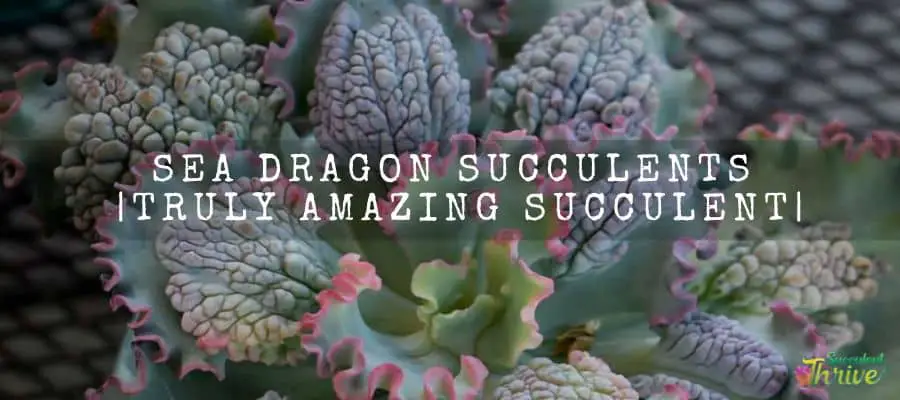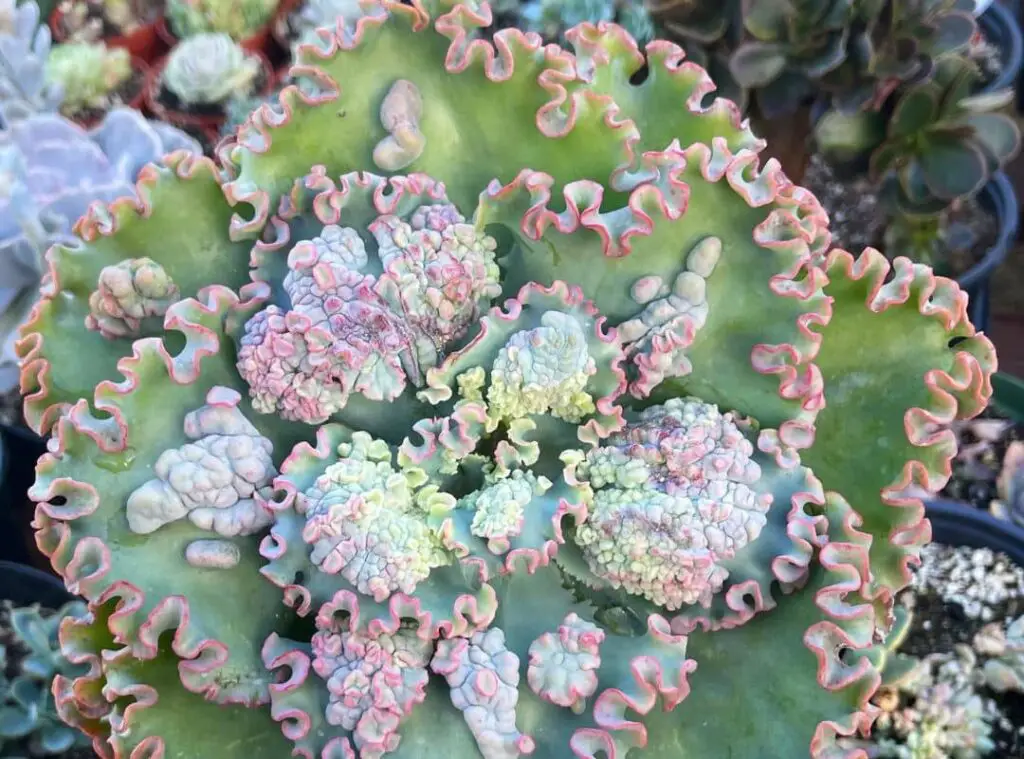Sea Dragon succulent is a popular low growing plant and many succulent lovers like to add them as ornamental plants. In fact, Renee O’connel from the USA is the creator of these plants.

They belong to the family Crassulaceae and the Echeveria genus. You can call them Echeveria sea Dragon too. You would commonly find this Echeverias in Mexico. Further you may also come across them occasionally in the USA as well.
Echeverias are polycarpic plants which literally means they can emerge with blooms several times in their lifetime. Furthermore, butterflies and bees are also attractive for these plants.
These are great starter plants since you can easily grow them as well as propagate them. If you are all set to grow these precious plants, you can continue reading this article.
How do I identify Sea dragon succulent?
Sea Dragon succulents are rosette forming plants. In fact, those rosettes are colorful. Besides, they would develop short stems.
They would attain a maximum height of 30 cm ( 12 inches ) when they are fully mature. Furthermore, they would be about 40 cm( 16 inches ) in width as well.
If I explain on the leaves of the Sea Dragon succulents, they will tend to take the shape of a big spoon.
Not only that but also, those leaves’ edges are wavy. The leaves are prominent in reddish green or gray green color. Furthermore, they would be about 20 cm in length as well. Apart from that in the middle of the foliage leave there is a unusual clump like structure and that add unique beauty to the plant.
Last but not least, Sea Dragon succulents would come up with blooms in reddish color. Apart from that the inside of the flowers would be yellow.
Size of the plant
Sea Dragon succulents would gain a maximum height of 30 cm ( 12 inches ). In addition to that these plants would be 40cm ( 16 inches ) broad as well.
Growth rate
Sea Dragon succulents are growing at a moderate rate usually.

One look care guide
| Botanical Name | Echeveria Sea Dragon |
| Common Name | Sea Dragon Succulents |
| Plant Type | Succulent |
| Mature Size | Maximum height of 30 cm ( 12 inches ) 40cm ( 16 inches ) wide |
| Sun Exposure | Full sunlight to partial shade |
| Soil Type | Well draining |
| Soil pH | pH range around 6.0 |
| Flower Color | Reddish |
| Hardiness Zones | 9a to 10b: from 20 °F (−6.7 °C) to 40 °F (+4.4 °C) |
| Native Area | Mexico |
| Toxicity | Non toxic |
| Average price | $ 39 |
How do you take care of the Sea dragon succulent?
Light Requirement
Sea Dragon succulents would grow well given that they get full sunlight during the morning when the conditions are not too extreme.
Once the conditions get too harsh particularly during the midday, they would prefer to grow under some light shade. So, if you had planted them in an outdoor garden, it has to be a spot where they will be secured from the harsh sunlight.
If you wish to utilize these plants for indoor gardening, I urge you to locate them in the sunniest spot at your home which would ideally be a bright sunny windowsill. However you need to still ensure that you protect the plants from the scorching sunlight.
On the other hand, if your Sea Dragon succulents are not gaining adequate sunlight, you can think of placing grow lights to supplement the same. Do not make them deprived of sunlight as it would not be beneficial on the overall healthy growth of the plants.
Temperature and humidity
Sea Dragon succulents would opt to grow in a temperature around 65 degrees Fahrenheit ( 18 degrees Celsius) when they are in their active growing season.
On the other hand, they would thrive well in a temperature around 50 degrees Fahrenheit (10 degrees Celsius ) during winter.
They have a frost tolerance of 32 degrees Fahrenheit ( 0 degrees Celsius ). So, if there is any forecast of much colder conditions, best would be to shift the plants insides so that they would not expose those unhealthy conditions.
Is it cold hardy?
Sea Dragon succulents are frost hardy up to 32 degrees Fahrenheit ( 0 degrees Celsius ).
Growth Zone of sea dragon succulent
Sea Dragon succulents’ preferred USDA Hardiness zones are 9a to 10b: from 20 °F (−6.7 °C) to 40 °F (+4.4 °C).
Watering Requirement
Watering the Sea Dragon succulents is a very delicate matter when it comes to looking after these plants well. Sea Dragon succulents are actively growing in summer and in spring.
So, you need to ideally water them moderately during these seasons. Further when you water them, you need to do it thoroughly.
However, you should not make it soggy. Instead make it moist. Furthermore, you need to ideally allow the soil’s top layer to wither between two watering sessions. Cut back in watering once the weather gets too colder.
Do not ever supply water in excess in winter as if you do so, it would pave the way for rot. Over watering could be the biggest root cause for many of the plant’s diseases. Hence, you need to always assure that you don’t water them in abundance.
Soil Requirement Type / pH.
An excellent draining soil mix is very crucial for the Sea Dragon succulents to grow to their best potential. Ph. level wise, a ph. range around 6.0 would work well with these plants.
In other words, they would thrive well in a slightly acidic soil mix. Having said that they can also perform well in neutral pH Many succulent gardeners tend to utilize the commercially made succulent cactus soil mix as they are well draining.
In addition to that, those soil mixes are usually well aerated too. Never use the regular soil mix to grow them as they would retain excess moisture within the soil mix and make your plants more susceptible for root rot etc.
Pot size Potting and Repotting
You need to go ahead with a pot which has ample drainage to grow the Sea Dragon succulents.
In addition to that, I recommend you proceed with unglazed , terracotta or clay pots to grow these plants. Those pot materials would not hold onto excess moisture for too long. Instead, they would evaporate it much faster.
In terms of repotting the Sea Dragon succulents, you need to ideally do it only if it is necessary. Further when you do it ideally you should do it in the warmer season.
However before you repot the plants, you need to make sure the soil is dry and only then proceed with repotting. To start off, you need to clean the older soil around the roots of the plants.
Next, have a closer look at the plants and see whether you could spot any decaying plant material. You need to get rid of whatever the decaying rotten plant parts in the plants and treat those with fungicides.
After that, you could pot them in the new pots and backfill with the potting soil. Next you need to allow the plants to wither for one or two weeks and then resume watering after that.
I recommend skipping watering for one or two weeks so that it would allow them to settle in the new conditions. Unless you apply water right after you repot them, it would make the plants prone for root rot.
Where to Plant
If you are wondering where to plant the Sea Dragon succulents, they would thrive in any spot as long as they can gain adequate sunlight.
Fertilizer and time of year
Sea Dragon succulents don’t have a higher demand when it comes to fertilizing. However, it would be beneficial for the plants if you can apply a controlled release fertilizer right at the start of their actively growing season.
Alternatively, you may also use a weak liquid fertilizer once a week. In addition to that, you may also use a balanced 20-20-20 fertilizer and dilute it to quarter strength and then apply on the mature plants. If you have young plants to feed, you can use a fertilizer which has a low nitrogen percentage.
Flower
Sea Dragon succulents may bear flowers in reddish color.
Dormancy
Sea Dragon succulents are winter dormant plants.
Toxicity
There are no records of Sea Dragon succulents being toxic.
Common bugs and illnesses
Sea Dragon succulents are usually resistant to diseases and to other problems. Having said that they may occasionally encounter mealybugs particularly if their conditions are to their liking.
If you come across any mealybug attack, you need to immediately quarantine the plants so that it would avoid any further potential spread to the other plants.
Furthermore, you can treat the affected plants with cotton swabs rubbed in alcohol or even use fungicides. Ensure that you remove all the dead leaves from the plants as only then these pests would feel welcome towards these plants.
In addition to that, Sea Dragon succulents may also come across root rot if there are waterlogged conditions for too long in their soil mix. Hence, it is always best to supply water moderately without supplying them with too much water.
Sea dragon succulent benefits
Many succulent fans tend to grow Sea Dragon succulents as ornamental plants due to the adorable looks. In addition to that they would look great in containers also which you can place either indoors or outdoors.
How to propagate Sea dragon succulent
You could use the seeds propagation method, offsets propagation method or even the leaf cutting propagation method to propagate the Sea Dragon succulents.
If I briefly explain each method, many people opt to go ahead with the lea cutting method when propagating the Sea Dragon succulents.
All you have to do is just obtain a leaf cutting from the mother plant and allow them to dry for one or two days. Then they will develop callus and after that you could simply place them in a well draining soil mix. I recommend you cover the planter until they develop the roots.
On the other hand, if you wish to proceed with the offset propagation method, you could simply remove the offsets from the mother plant and allow them to dry for a few days .Next you can pot them individually.
Conclusion
Sea Dragon succulents are super cool plants which would be great to have. They would adore the entire space and would bring a sense of freshness wherever you grow them.
So I hope this information was useful for you and now that you are all set to begin cultivating the Sea Dragon succulents.
Read Next : Succulent Terrarium Layers |Everything You Need To Know|
